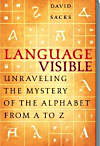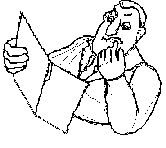

| Book of the Month | ||
 |
Language visible |  |
Publisher: Random House
Author: David Sacks
$29.95
ISBN 978-0676974874
As this book points out, writing was one of the great inventions of history, equal to the discovery of fire and the wheel. Thanks to writing, the words of Julius Caesar are as clear now as when he wrote then thousands of years ago. Writing preserves ideas, and allows one person to speak to many. Yet before writing comes the alphabet - just over two dozen little symbols which, in their various combinations can say almost anything. This book is the story of these symbols. In a way we can say that they are twenty-six little biographies, each introducing a letter of the alphabet, where it comes from and how it is used.
As is logical for a book of this sort, the main part of the book consists of twenty six chapters, each devoted to a particular letter. (The book was originally a series of articles about the alphabet, each published separately in a Canadian newspaper.) However, there is also a long (42 page) introduction about the alphabet generally including the observation that the name 'alphabet' itself comes from the first two letters in Greek (alpha, beta). We are introduced to some of the oldest forms of the letters we know today, and discover that some still resemble their original pictograms (pictures which make letters).
So we can still see why 'o' was originally a pictogram for 'eye' and why 'H' was a fence. The symbol for 'water' was not 'w' as we would imagine, but 'm' which also works well. It seems that the very first letters of our alphabet date back to around 1800 BC. In this, the letter 'E' looked like a person throwing up his hands in surprise - 'eek!'. (Turn the letter sideways, and add a head to the middle bar of the E to see roughly how this looks.) The amazing thing about our alphabet is how it has made the move from ancient Semitic languages to Greek to Etruscan to Latin to dozens of modern languages. Even though the languages are completely different the alphabet has been adapted to serve them all.
Along the way certain letters have been added - for example 'J', and others have disappeared such as the Greek 'big O' or 'omega' and the 'thorn' (Y) for 'th'. (So old English spellings such as 'Ye Olde Shoppe' should be unromantically pronounced as 'The Old Shop.') The book is beautifully illustrated with maps,diagrams and examples of the alphabet in use over the ages. It also has a detailed index.
Who is this book for? It is not for the professional specializing in words, and the text contains humour that non-native speakers might find difficult (for example: 'There is sometimes a silent P in 'swimming''). However, anyone who loves language and writing will find this book packed with interesting and unexpected facts. Also any advanced student who wants to know more about the origins of the many bizarre spellings and pronunciations will find some answers here.
Verdict: An interesting but non-essential read
Assessment 9/10